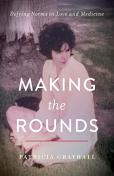BKMT READING GUIDES
Making the Rounds: Defying Norms in Love and Medicine
by Patricia Grayhall
Paperback : 344 pages
2 clubs reading this now
0 members have read this book
Introduction
Defying expectations of a woman growing up in Arizona in the 1960s, Patricia Grayhall fled Phoenix at nineteen for the vibrant streets of San Francisco, determined to finally come out as a lesbian after years of trying to be a “normal” girl. Her dream of becoming a physician drew her back to college, and then on to medical school in conservative Salt Lake City.
Though Patricia enjoyed a supportive friendship with a male colleague, she longed for an equal, loving relationship with a woman. But her graduate medical training in Boston, with its emotional demands, long hours, lack of sleep, and social isolation, compounded by the free-wheeling sexual revolution of the 1970s, made finding that special relationship difficult. Often disappointed but never defeated, Patricia—armed with wit and determination—battled on against sexism in her male-dominated profession and against discrimination in a still largely homophobic nation, plunging herself into a life that was never boring and certainly never without passion.
A chronicle of coming of age during second-wave feminism and striving to have both love and career as a gay medical doctor, Making the Rounds is a well-paced and deeply humanizing memoir of what it means to seek belonging and love—and to find them, in the most surprising ways.
Editorial Review
No Editorial Review Currently AvailableExcerpt
Lead in: David, a fellow medical student. is my best friend and roommate. We’ve just found out we matched at the same hospital in Boston for our internships. We are just finishing up our fourth year of medical school with one more rotation to go. ...Discussion Questions
From the author:As a teenager, Patricia researched homosexuality in the public library and read that homosexuals were mentally ill, could not hold down jobs, sustain relationships, and were doomed to lead unhappy lives. How are things different today? How are they the same in parts of the country?
At age 17, Patricia had a relationship with a much older man, a teacher at her high school. Do you think she was purely a victim of a sexual predator?
At age 19, Patricia becomes pregnant after one incident of unprotected sex. She felt pregnancy would ruin her education, her life, and her plans to become a scientist. If she had been forced to bear the child--as millions of women in the US will be now that the Supreme Court has overturned Roe--how might her life have been different?
How are things different today compared to pre-Roe for women who experience an unplanned pregnancy in states that have banned abortion for any reason?
Why do you think 21% of young women today believe that abortion should be illegal?
In medical school, Patricia was one of only five women in a class of 100 and the only woman intern at Boston University Hospitals. There were few women physician role models and other women were often not supportive. How did Patricia adapt to this environment?
How did male domination of the medical profession before Title IX influence the culture of medical care?
How has the increased number of women in medical school, residency and practice changed the culture of medicine today? As a group, do women physicians have better health outcomes for their patients?
What were feminists telling women about the heteronormative model of relationship in the 1970s? How did that affect Patricia’s search for a satisfying relationship?
Throughout her twenties, Patricia had several relationships with women, some brief and some lasting 1.5 to 5 years or longer. Do you think it was more difficult to sustain a fulfilling, monogamous same-sex relationship in the 1970s than it is today? Why?
Do you think people in same-sex relationships today struggle with the same issues as heterosexual couples? For example, fidelity, money, children, equality in household responsibility, work-life balance?
How did second wave feminism of the 1960s and 1970s contribute to the rights and freedoms for women and LGBTQ people over the past 50 years?
We are going backwards in the US regarding human rights for women. Do you think the pendulum will swing backwards for LGBTQ human rights also?
Did you learn anything relevant to your own life after reading this book?
Book Club Recommendations
Recommended to book clubs by 0 of 0 members.
Book Club HQ to over 90,000+ book clubs and ready to welcome yours.
Get free weekly updates on top club picks, book giveaways, author events and more








